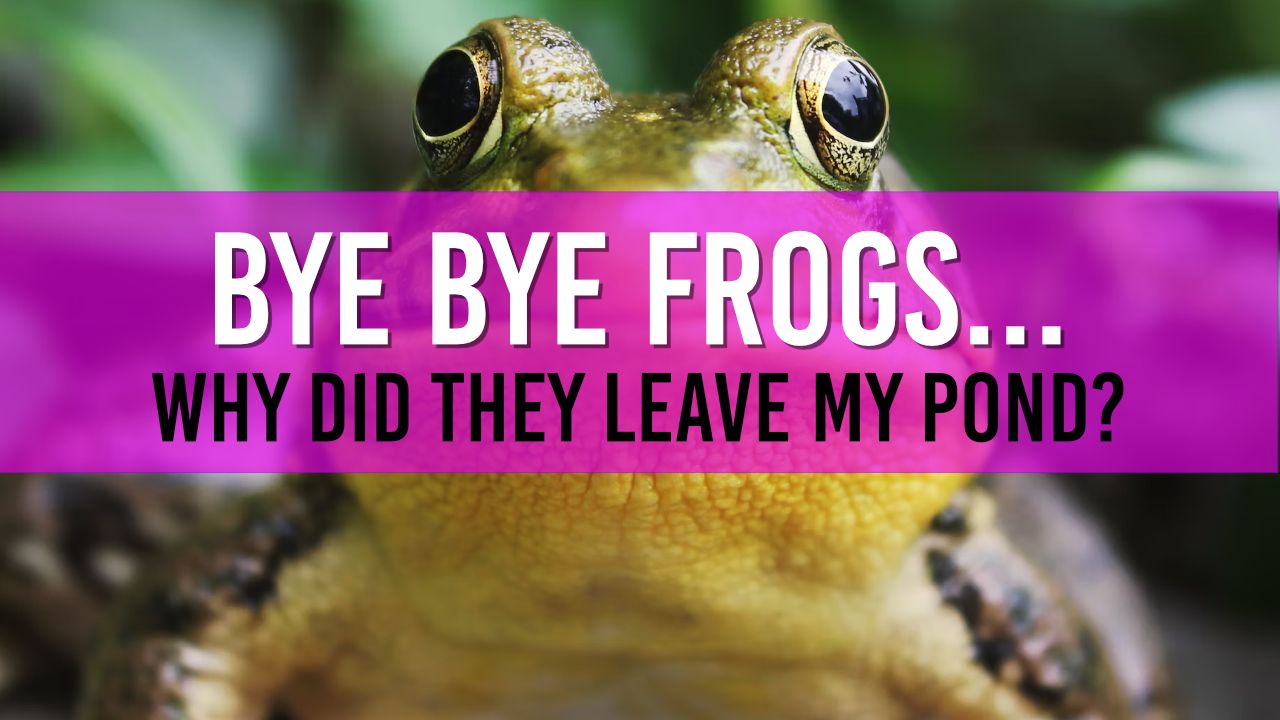Where did all my Frogs go?
Frogs can go as quick as they arrive, so ensuring your pond has the perfect eco-system, clean & healthy water, Frog friendly food and suitable hiding spaces will ensure your Froggy friends stick around year on year.

Table of Contents
The world of garden ponds is fascinating. They bring not just a sense of tranquillity but also a burst of life in the form of shimmering fish and chirping amphibians. Having had my very own pond for several years, I understand the concern when our little croakers decide to leave suddenly. Let's unravel this mystery together.
Natural Migration
Amphibians, especially frogs and toads, exhibit migratory patterns that are often influenced by environmental cues. They might be seeking larger ponds, more suitable breeding grounds, or even responding to atmospheric changes. As ponds can become bustling ecosystems, sometimes they might just be exploring the neighbourhood. For a comprehensive understanding of pond habitats, the PondAnswers guide is a goldmine.
Predators
Nature has its own food chain. Birds, snakes, raccoons, or even curious domestic cats might view your frogs as a tasty treat. It’s vital to ensure that your pond is a safe haven from these predators. Look for signs of unusual visitors or check out the section about pests for insights.
Pond Health
Water quality is paramount for the survival of all pond creatures. Changes in pH levels, high ammonia, or nitrate concentrations can upset them. Maintaining a clean pond might involve routine checks, ensuring optimal filtration, or even understanding why your pond water might appear dirty.
Breeding Season Over
Once the breeding season culminates, adult frogs may seek new habitats, especially if they sense overcrowding. Creating spaces for your frogs to leave after the 'rumpy-pumpy' time is over will ensure they stick around.
When do Frogs breed in the UK?
- Early Spring in the UK is usually the start of Frog breeding season.
- Listen for increased "croaks" during this period (and ensure you adhere to the do not disturb signs on your Frog houses)
- Croaking Frogs are generally from the Male frogs trying to attract Females to mate.
Human Activity - Leave that rock alone!
Frogs and toads are, by nature, shy creatures. Excessive noise, frequent movement, or even changes near their habitat can deter them. Reflect on any recent activities or modifications near the pond that might be causing this exodus.
Pond Maintenance
Frogs are sensitive to changes in their environment. Introducing a new UV lamp, switching to a different pond pump, or even minor adjustments to the pond structure can lead them to explore new habitats.
Seasonal Changes
Seasonal transitions, especially the onset of colder months, prompt amphibians to seek terrestrial sites for hibernation. Your autumn pond preparations can impact their decisions. It’s crucial to ensure that these changes are gradual and non-disruptive.
Insufficient Food
A thriving pond ensures a continuous food supply for its inhabitants. From insects to smaller aquatic creatures, the diet of frogs and toads is diverse. To ensure they stay, ensure the pond ecosystem is rich and thriving, attracting ample food sources.
What do Frogs eat?
Like a menu at a restaurant, I'm going to split the diet of frogs between "Tadpoles" and "Adult Frogs"
Tad Poles:
- Algae
- Plant Matter (Lilies / Oxygenators etc)
- Fish Flakes (Any off the shelf Fish Flakes)
- Watermelon (Place a slice in the pond and remove after a couple of hours)
Adult Frogs:
- Insects - Flies / Mosquitoes / Beetles / Moths / Dragonflies
- Spiders
- Worms
Disease
Diseases like the Chytrid fungus can affect amphibian populations. If ailing frogs are spotted, it's essential to understand the cause and possibly seek expert advice. Healthy frogs might leave to avoid the spread.
How Can I Encourage Frogs to Breed in My Pond?
Frogs, with their playful leaps and soothing croaks, are not just delightful to observe but are also great indicators of a healthy pond ecosystem. If you're hoping for tadpoles and increased froggy activity, here's how you can set the romantic stage for them:
1. Provide Ample Shelter

Ensuring your pond has a variety of aquatic plants is paramount. These provide safe areas for frogs to hide, mate, and lay their eggs. Floating plants like lily pads or submerged vegetation are not just aesthetically pleasing but create those essential hiding spots. Check out tips on when's the best time to plant pond lilies and which varieties to choose.
2. Keep the Water Clean
Clean water is essential for frog breeding. Stagnation or pollution can deter them from mating. Regularly remove debris, and if you haven't already, consider investing in a pond filter. Get insights on why your pond water might be dirty and how to address it.
3. Create Shallow Areas
Frogs and toads often prefer shallower sections of the pond for mating and laying eggs. These areas warm up faster in spring, providing an ideal environment for tadpole growth. Adjust your pond depth in places or add flat rocks to create these shallower zones.
Creating shelves in your pond will certainly allow frogs to enter and exit your pond with ease. It's worth nothing, that even though I have frogs in and around my raised pond, it's not been a smooth ride.
4. Ensure Safety from Predators
A pond constantly visited by predators can make frogs feel unsafe, reducing their chances of breeding. Look into natural deterrents or barriers to keep unwelcome guests away. Dive into the pests section for more insights on safeguarding your amphibian friends.
5. Maintain a Balanced Pond Ecosystem
A pond teeming with large fish might not be conducive for frogs, as they could prey on frog eggs and tadpoles. Striking a balance in your pond's ecosystem, ensuring there's enough food and safety for everyone, can be key. Explore how to keep your pond's wildlife in harmony.
6. Avoid Pond Chemicals
Avoid using harsh chemicals or pesticides in or around your pond. These can be harmful to frogs and might deter them from breeding - Natural solutions to pond problems whenever possible.
Closing Thoughts
It's delightful to have frogs and toads around, making our ponds lively with their presence. Their departure, although sometimes seasonal or temporary, can be a call to action for pond owners. Regularly checking on aspects like pond liners, plants, and overall pond health can make a world of difference.
Happy ponding!

